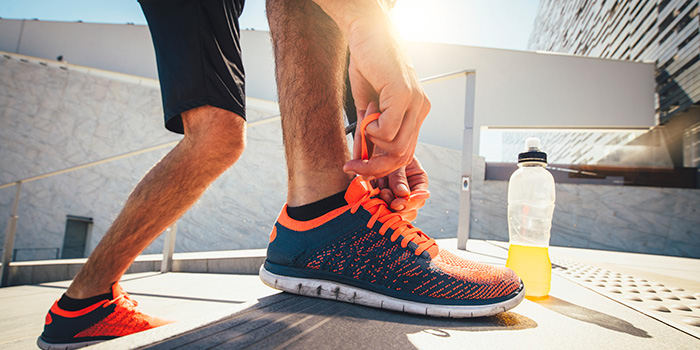The Science Behind Hydrate

Simply put, hydration has a massive impact on athletic performance, so the obvious solution is to drink more water, right? Maybe not.
In day-to-day situations, water is an ideal hydrator, but when you’re exerting yourself, factors such as fluid imbalance and electrolyte loss — which can lead to reduced performance, cramps, and other issues — come into play.
So it’s on to Plan B: Grab yourself a sugary sports drink. That way, you get fluids, electrolytes, and glycogen-restoring carbohydrates. Again, maybe not.
Thanks to a process called osmosis, sports drinks that are too high in sugar do not hydrate effectively and can absorb into your system inefficiently, staying or “sloshing” in your stomach, causing bloating and cramping, and again, impacting your performance.
The trick to the perfect performance hydrator is balance. Because, thirstiness aside, who wants to fall behind simply because they’ve got the wrong drink? Fluid loss equals power loss — and Hydrate (a member of the Beachbody Performance line) aims to take any loss out of the equation.
“The idea of Hydrate is to optimize fluid absorption and fluid balance during exercise,” says Nima Alamdari, PhD, Executive Director of Scientific Affairs at Beachbody. “And optimizing fluid balance is important because we know it has a direct correlation to performance.”
In fact, would you believe a one to two percent drop in optimal body water can lead to over a 10 percent loss in maximum power? “If I’m a cyclist, I am going to be pretty interested in those numbers,” Alamdari said. “I am certainly going to want to pay attention to my hydration status because that can delay power decline and fatigue.
With that in mind, Beachbody has engineered Hydrate as part of its Performance lineup to maximize fluid absorption, doing that through a hypotonic formula — the osmolality is lower than your blood so there is fast fluid absorption by your body.
There are three basic types of sports drinks, hypotonic, isotonic, and hypertonic, all with a different osmolality, which indicates the amount of solutes (dissolved substances) in the liquid and its rate of absorption through a permeable membrane like your gut lining.
A hypertonic drink has a higher osmolality than your blood; one that is isotonic is the same as your blood; and a hypotonic drink has a lower osmolality than your blood. Through osmosis, liquids with a lower concentration of particles will cross the membrane to where the higher concentration is in order to create fluid balance. So a hypotonic drink will enter your bloodstream more quickly than an isotonic or hypertonic drink.
Traditional sports drinks on the market emphasize energy replenishment and lean more toward carbohydrates as fuel as the primary driver for performance enhancement.
That, in turn, creates a hypertonic drink with a higher osmolality that the body will absorb more slowly. They are essentially trying to create a product that provides both energy and hydration, but the solution can lose effectiveness. While it supplies sugar for fuel, the osmolality may be too high to efficiently mitigate fluid loss.
“High-sugar sports drinks are not optimal for hydration. The carbohydrate level is too high,” Alamdari says. “That can lead to delayed gastric emptying. It can sit in your stomach. Ultra-endurance athletes or marathon runners will often talk about stomach ‘sloshing’ or [gastrointestinal] distress.”
Hydrate’s citrus flavor has also been formulated to lessen flavor fatigue — a common occurrence in endurance athletes, who sometimes lose tolerance for the taste of their during-event supplements after hours of consuming them.
“Hydrate was formulated with a balanced, not overwhelming flavor or sweetness,” says Denis Faye, Beachbody’s executive director of nutrition, and an ultra-endurance cyclist. “I can tell you firsthand that when you’re 8 hours into an event and your sports drink starts tasting like ash, it’s a problem. Hydrate avoids this nicely.”
Like the entire Beachbody Performance line, Energize is screened for substances banned by most major athletic organizations.
Alamdari said they also looked at the World Health Organization’s method for producing rehydrating drinks for developing countries. “The World Health Organization (WHO) oral rehydration solution recognizes the superiority of a low-osmolality, hypotonic solution for countering dehydration and promoting better fluid balance. “
Finally, Hydrate stands apart because it contains quercetin, a phytonutrient researched for its capacity to improve exercise performance, increase energy production, and reduce exercise-induced inflammation.
“We included quercetin because it’s the most researched phytonutrient for improving exercise performance,” Alamdari says.
Quercetin is believed to work both acutely and chronically, meaning you should experience benefits on the day of as well as through long-term use. The acute benefit works well here because the longer you exercise, the more Hydrate you drink. And the more Hydrate you drink, the more quercetin you consume to continue pushing performance.
This means it also works cumulatively with Energize, the Beachbody Performance pre-workout supplement. “It complements Energize but it also has its own distinct benefits,” explained Alamdari. “We didn’t just want the most effective hydrator; we want to be the most effective performance-enhancer.”
Intense exercise can take a lot out of you — literally. Not only do you lose water and electrolytes as you sweat, but you also burn through carbs (in the form of glucose and glycogen) as your body’s demand for energy increases. Beachbody Performance Hydrate helps replace those losses.
And as Dr. Marcus Elliot, founder of the Peak Performance Project (P3) explains to Beachbody President and CMO Jon Congdon in this video, the result is a greater capacity for high-intensity work. In short, Energize can help improve both your endurance and exercise performance.

